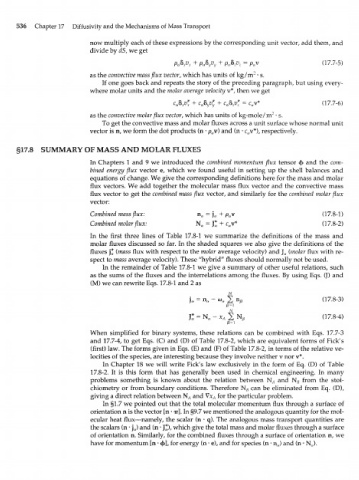Page 556 - Bird R.B. Transport phenomena
P. 556
536 Chapter 17 Diffusivity and the Mechanisms of Mass Transport
now multiply each of these expressions by the corresponding unit vector, add them, and
divide by dS, we get
PA^.Y + Pa&yVy + p b v = p v (17.7-5)
a
a z z
as the convective mass flux vector, which has units of kg/m 2 • s.
If one goes back and repeats the story of the preceding paragraph, but using every-
where molar units and the molar average velocity v*, then we get
c<$ v* + c b v* + c b v* = c v* (17.7-6)
x a y Q z a
as the convective molar flux vector, which has units of kg-mole/m 2 • s.
To get the convective mass and molar fluxes across a unit surface whose normal unit
vector is n, we form the dot products (n • p v) and (n ° c v*), respectively.
a
a
§17.8 SUMMARY OF MASS AND MOLAR FLUXES
In Chapters 1 and 9 we introduced the combined momentum flux tensor ф and the com-
bined energy flux vector e, which we found useful in setting up the shell balances and
equations of change, We give the corresponding definitions here for the mass and molar
flux vectors. We add together the molecular mass flux vector and the convective mass
flux vector to get the combined mass flux vector, and similarly for the combined molar flux
vector:
Combined mass flux: n a = ) a + p v (17.8-1)
a
Combined molar flux: N a = J* + c v* (17.8-2)
a
In the first three lines of Table 17.8-1 we summarize the definitions of the mass and
molar fluxes discussed so far. In the shaded squares we also give the definitions of the
fluxes * (mass flux with respect to the molar average velocity) and j u (molar flux with re-
j
spect to mass average velocity). These "hybrid" fluxes should normally not be used.
In the remainder of Table 17.8-1 we give a summary of other useful relations, such
as the sums of the fluxes and the interrelations among the fluxes. By using Eqs. (J) and
(M) we can rewrite Eqs. 17.8-1 and 2 as
N
) a = n a - (D 2 Щ (17.8-3)
a
0=1
j : = N - x f Щ (17.8-4)
a A
/3 = 1
When simplified for binary systems, these relations can be combined with Eqs. 17.7-3
and 17.7-4, to get Eqs. (C) and (D) of Table 17.8-2, which are equivalent forms of Fick's
(first) law. The forms given in Eqs. (E) and (F) of Table 17.8-2, in terms of the relative ve-
locities of the species, are interesting because they involve neither v nor v*.
In Chapter 18 we will write Fick's law exclusively in the form of Eq. (D) of Table
17.8-2. It is this form that has generally been used in chemical engineering. In many
problems something is known about the relation between N^ and N B from the stoi-
chiometry or from boundary conditions. Therefore N can be eliminated from Eq. (D),
B
giving a direct relation between N^ and Vx A for the particular problem.
In §1.7 we pointed out that the total molecular momentum flux through a surface of
orientation n is the vector [n • IT]. In §9.7 we mentioned the analogous quantity for the mol-
ecular heat flux—namely, the scalar (n • q). The analogous mass transport quantities are
the scalars (n • j ) and (n • J*), which give the total mass and molar fluxes through a surface
a
of orientation n. Similarly, for the combined fluxes through a surface of orientation n, we
have for momentum [n • ф], for energy (n ° e), and for species (n • n ) and (n • N ).
a
a

